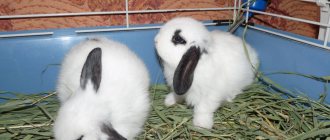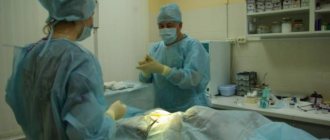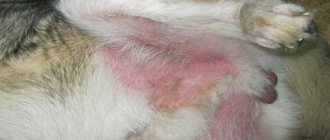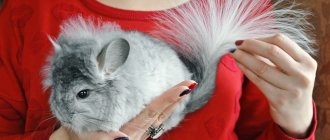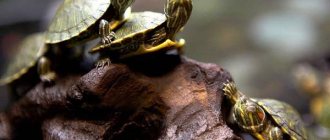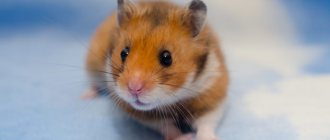You choose a budgie: where to start caring for the bird
At the first inspection, you need to pay attention to the fact that the chick is active. This can be determined by rapid springy movements, quick reactions, and a desire to interact with the outside world. He should have shiny eyes, smooth plumage that fits tightly to the body, light breathing without hoarseness and clean feathers in the anus.
Budgerigars have a variety of colors
It is also necessary to examine the beak, which should be smooth, dry, without secretions and foreign formations, the wax and paws, which should not show signs of peeling. The claws should not peel off. Caring for a budgie will be easier if you have information about the bird.
Boy and girl budgerigar
It is also important to make sure that the bird is young enough, this can be determined by the wax (in young birds it is always a delicate pale pink or bluish color), by the frontal feathers decorated with contrasting colored stripes (by 6-7 months of age these stripes are highlighted) , and in the eyes (in chicks they are uniformly dark, in adults a gray and later a white rim appears along the outer edge).
Budgerigar chick
If the sex of the bird matters for the purchase, since there is an opinion that males are more talkative, then the “boy” chick has a lilac cere (in an adult it is deep blue), the “girl” has blue, white, beige, (in an adult it is brownish ) around the nostril openings there are characteristic white rings.
Video: how to determine the sex of a budgerigar
If we talk in general about breeds of parrots, then the most popular, affordable and easy to keep will, of course, be the budgerigar, whose homeland is the grassy plains of Australia. Cockatiels and lovebirds are also quite popular.
Lovebirds
Corella is also an Australian, the smallest member of the cockatoo family, and lovebirds are native to Africa and Madagascar. Their small size makes it possible to keep these beauties in an ordinary apartment, in a fairly compact cage, without any problems. When choosing a larger bird (for example, a Gray), it is important to take into account that it needs a large, spacious cage or aviary.
Features of feeding budgies
A budgerigar needs not only careful care, but also proper feeding.
The main components of the diet are as follows:
- greenery;
- cereals;
- fruits and vegetables;
- proteins.
Wavys need to be fed with greens.
The basis of the diet is grain feed. Nowadays there is a large selection of food for different types of birds on sale, so you can easily choose the one that suits your pet. You can supplement it with porridges (buckwheat, rice, millet). It is necessary to give your pet fresh greens:
- dandelion leaves;
- salad;
- dill;
- spinach;
- plantain;
- wild cereals;
- dried nettle.
Fruits and vegetables are also beneficial:
- banana;
- orange;
- apple;
- pear;
- pieces of zucchini or pumpkin;
- grated carrots;
- beet;
- turnip;
- berries.
Parrots eat pears.
Chopped eggs and stale white bread are suitable as protein foods. It must be remembered that your pet should always have a drinking bowl with fresh water, to which you can periodically add a few drops of lemon, orange or grapefruit juice.
Keeping a budgerigar: criteria for choosing a cage
When buying a cage, it is important to understand that it is your parrot's home, so he should feel comfortable in it. Keeping budgies should begin with the choice of future “apartments”. Spacious and multi-tiered, with the ability to install perches, rings, toys, several feeders, a drinking bowl, a bathing container - an ideal choice, partly compensating for being kept in captivity.
It is also important that the cage is easy to use and made of durable material. A cage with metal bars would be the best option, since a wooden one has a risk of parasites and is guaranteed to absorb and stagnate a specific odor.
You should not place the cage too close to the window, as drafts may cause the bird to get sick.
It is advisable to structure the parrot’s keeping regime so that it has the opportunity to spend as much time as possible outside the cage, fly, move, and communicate. An insufficient number of flights will quickly affect your health, primarily on your respiratory function, which is directly related to the functioning of the wings.
How often should you clean your cage? The care and maintenance of budgies at home requires a number of rules. We need to start with cleanliness. As you know, cleanliness is the key to health. That is why cleaning should be done daily.
The cage needs to be cleaned regularly
If for some reason (departure, busyness, natural laziness) this does not work out, then you can add wood filler to the sand in the tray of the cage, as for a cat litter box, so that it absorbs the smell and moisture, but you should not abuse it.
It is necessary to clean the perches of droppings, pour boiling water over the drinking bowls, and remove husks and remaining food from the feeders. Sand and absorbent paper must be changed once a week. You should also disinfect the cage with a 1-2% solution of potassium permanganate.
Video: how to choose a cage for a budgie
Cell
To make keeping budgies in a house or apartment comfortable, it is important to first choose a suitable cage. This is where they will spend the majority of their time, so it should be comfortable, well-equipped and spacious. Birds of this breed love space. For this reason, it is better to purchase a large cage so that they can move around freely.
Cell selection
Budgerigars should feel comfortable at home; nothing should disturb them or cause them discomfort. The first step is to purchase a cage for them.
When choosing a cage, you need to consider important features:
- size. The home should be spacious;
- if you plan to keep one parrot, then a small cage with dimensions of 35x35 cm is suitable for it, but for a married couple the smallest area will be 65x55 cm;
- It is worth taking into account the frequency indicators of the wire location. It should create a lattice with a density that will not limit the bird’s head from sticking in, which could result in injury;
- A cage with a rectangular shape is suitable for living; its top should be domed;
- the bottom section of the cage should be made of hard wood or a metal base;
- The base of the wire should not be made of copper. Birds can suffer from metal oxide poisoning if they chew on the wire.
Choosing a place in the house
To keep your budgie happy, it is important to pay special attention to its maintenance. The cage must be installed in a suitable area. The kitchen, hallway, bathroom, walk-through room are not the best places for this bird. It must be placed in a quiet and secluded area of the house.
When considering the important question of how to care for budgies at home, it is worth paying special attention to the place where the cage will be installed. To do this, you need to remember a few features:
- the cage with the bird should not be in drafts, near window openings or heating devices;
- during warm periods, it is recommended to place the cage with the parrot on the balcony;
- fresh air and sunlight have a positive effect on the pet's health. But in strong sun, the side of the cage needs to be covered with a cloth.
Arrangement of the cage
Once the cage is selected and installed, it is worth moving on to arranging it so that the bird can live comfortably in it. At this stage, it is recommended that the future home be fully equipped; it should contain all the important elements for the normal functioning of the feathered pet.
We recommend reading: What to do if your budgerigar’s legs hurt
Keeping a budgie is a responsible matter, so you should treat it carefully and not miss even the little things. If you want the bird to live a long time and not experience problems, then be sure to arrange the cage as needed. It should have wooden perches. They will serve as a place for the bird to sit, rest and play.
Perches should be installed in areas of the cage where the parrot will not clog drinking bowls and feeders with droppings. In this case, the bird’s tail should not touch the walls of the cage.
It is recommended to use the following types of wood for perches:
- oak, beech, maple, birch. Wood of this type is considered quite wear-resistant, it has a positive effect on the condition of the feathered pet;
- willow. Perches made from this tree will be very durable; willow also has healing effects;
- apple, pear, plum, cherry, rowan. Perches made from these types of wood will make a tasty seat for parrots. They contain many nutrients.
Coniferous trees (spruce, pine, cedar) cannot be used for perches. They can cause various health problems in birds. Do not use poisonous breeds.
Food bowls and a drinking bowl with water are placed in the cage. There can be 2-3 of them, the water in them needs to be changed every day.
You need to place 3 feeders in the cage:
- one feeder for feed mixtures with minerals - crushed eggshells, red clay, sand, charcoal;
- a bowl for feed mixtures in solid form - millet, grain, barley, millet;
- container for soft feed.
Important! Birds love to swim in the hot season; budgerigars often do this in drinking bowls. In this case, the water spills, the cage becomes dirty, and the feathers fly to the sides. To prevent this, it is worth installing special bathing containers.
Additionally, for games and development, a swing with swinging ladders is placed in the cage. They are useful for the development of the muscles of the birds' legs. Stones of different sizes and toys can be placed on the surface of the bottom of the cage.
Cage care
Caring for budgies should include cleaning their home. For cleaning you will need regular warm water without impurities and detergents. There is no need to add powder to it. You can use an old toothbrush for washing.
When cleaning, you should consider a number of recommendations:
- all elements must be washed and wiped dry;
- It is worth removing the pan especially carefully, as there is always a lot of dirt;
- All feeders and drinking bowls should be washed thoroughly.
Communication with a budgie is an important component of care and maintenance
In addition to the nuances discussed above, it is important not to forget about communication. After all, when purchasing a parrot, you want to get a friend or home decoration, so you should not reduce the care and maintenance of budgies to cleaning the cage. You need to devote time to the bird itself.
Parrot needs attention
The first rule is not to force yourself on the bird, give it the opportunity to get comfortable, to understand that it has everything it needs for a comfortable existence (including peace).
After your pet gets used to you and the new environment a little, you need to let him out of the cage. It makes sense to wear clothes made of thick, easy-to-clean fabric for these cases if you want to train your feathered friend to ride on your shoulder like a pirate, but don’t want to be scratched by claws or “marked.”
A budgie on your hand is an indicator of trust
The effectiveness of the learning and taming process of words and phrases will depend on many factors. For example, it depends on the breed, age, and whether the parrot is kept alone or in a pair (in this case, the birds are usually busy with each other). Grays, for example, are considered the most capable and susceptible to remembering human speech.
There is an opinion that the more often you repeat the same phrase or word, the faster the bird will remember and reproduce it. This is not true, but sometimes a pet can remember a phrase it has heard only once. Particularly talented ones can even convey entire dialogues and quotes from films verbatim, as well as imitate various sounds: car alarms, dog barking, mobile ringing, and even maintain some illusion of a conversation with the owner, which greatly amuses both owners and guests.
Video: how to teach a wavy to speak
Budgerigars are more predisposed to reproducing human speech; it is much more difficult to teach a cockatiel or lovebirds to speak. There is no point in turning the process into training, just talk to your winged counterpart every day, as you would with a family member, then the need to respond to you will come to the bird on its own.
Bathing
The next interesting question is how to care for budgies in the summer. In the warm season, there must be a bath in the cage. Little birds love to splash in the water in hot weather. Choose a small container according to the size of the pet. You should not pour a lot of water to prevent your budgie from choking. It is enough for him to wet the feathers well.
If the bird does not like to swim, you should not insist on it. You can gradually accustom him to water. It is good to spray the bird in hot weather. Over time, she will like this procedure. Care and maintenance at home depends on the owner. Only he can create the most comfortable environment.
Budgerigar diseases and precautions
Keeping a parrot at home is a responsible task also because you need to monitor the pet’s health and understand how to care for it. To eliminate the possibility of drafts, so as not to chill the delicate tropical creature, install additional protective nets on the vents and windows to prevent accidental flight outside the apartment.
Mosquito net will protect parrots from flying out
Closely observe the behavior of the wavy. Lethargy, drowsiness, photophobia, and refusal to eat may indicate the onset of the disease. Some of the diseases, being infectious, can be transmitted to people. We are talking about diseases such as:
- Salmonellosis. It is difficult to detect; often the bird is only a carrier, a reservoir of the disease.
- Tuberculosis. It is characterized by deterioration of the plumage, the appearance of ulcers and enlarged lymph nodes. There is practically no treatment for birds.
- Arizonaosis. With arizonosis, anorexia, weakness, and tremors develop, but timely measures taken give a positive outcome.
- Chlamydia. Signs of chlamydia in parrots: diarrhea, cough, nasal discharge. It happens very quickly, often with a deadly ending.
Most of the listed diseases are transmitted by bacteria in the droppings, therefore, if infection is suspected, it would be useful to clean the cage wearing a protective mask and medical gloves.
Video: how to rid your budgie of ticks
Breeding budgies at home
If your plans include increasing the population of flying pets, then this will require the creation of a number of conditions for reproduction. Breeding parrots in an apartment is not a difficult task, but it is troublesome.
The most difficult thing is to choose a pair and understand how to properly care for a budgie if it lives with a “family”. Breeders who have several individuals and, accordingly, room for choice, do this by observing the parrots in a large aviary.
If parrots mutually care for their plumage, treat each other, feed each other, and “kiss”, then they have every chance of having offspring. Then, if necessary, you need to artificially increase the daylight hours to 14-16 hours, equip the cage (preferably with two doors) with a “nest” - a house closed from prying eyes, where the female could calmly lay a clutch and hatch the chicks. Proper care and feeding of budgies is especially important during this period!
During this period, along with the usual grain mixture and juicy additives, they should be fed with sprouted grain, soft, easily digestible food. The quality of the masonry can be checked after a week using a flashlight or an ovoscope. If the female has settled stably on the eggs, and the male has taken care of her, there is hope that the pair has taken off.
When partners quarrel, the mother often leaves the nest, abandoning the clutch to the mercy of fate, or deliberately breaks the shell (which happens with young, inexperienced birds), it makes sense to replace one of the parents. By observing all the criteria for proper maintenance, it is quite possible to get beautiful, colorful, healthy offspring from your couple.
Video: breeding budgies
How to care for a budgie at home
If you are planning to purchase budgies, be sure to study all the important features of care and maintenance at home. It is important that feathered pets are always in perfect order. To do this, you should follow the recommendations and follow the rules of content.
Proper nutrition
The health and proper development of domestic budgies depends on proper nutrition. The menu of a feathered pet should be balanced, it should contain food mixtures with a high level of useful components. They will be able to prevent the development of dangerous poultry diseases, strengthen their immunity and the body’s protective properties.
We recommend reading: Basic information about the budgie
Feeding your budgie should be based on grain feed. The largest part should be millet. But to prevent parrots from having problems with the digestive system, feeding grain mixtures should be in a certain percentage ratio:
- yellow millet – 50%;
- white millet – 25%;
- millet with red color – 15%;
- Hulled oats – 10%.
So what else to feed budgies? Additionally, the menu should include other types of food:
- greenery. In the warm season, the bird will happily eat fresh lettuce leaves, a mixture of plantain, dandelion, and clover greens. In winter, sprouted oats are suitable;
- fresh vegetables and fruits, berries. Parrots will eagerly eat fresh carrots, cucumbers, tomatoes, cabbage, zucchini, and radishes. Among fruits and berries, preference should be given to apples, grapes, bananas, peaches, raspberries, strawberries;
- minerals. The parrot should sometimes be given chalk and sepia, it is sold in any pet store.
Communication
Budgerigars are endowed with good intelligence and intelligence. They are very sociable, therefore they require increased attention from humans or their relatives. If a bird is bored, it will quickly begin to waste away.
When keeping budgies at home, you should not forget about communication and attention. It is important to talk to your feathered pet every day and play with it. When you enter, be sure to say hello to the bird and ask how it is doing.
You should already know from behavior what a budgie needs. If he tweets and chirps intensely, then he shows you his attention and wants to talk. Don't ignore it, play with it, talk to it, sing a song.
Freedom for parrots
Many beginners often wonder: is it necessary to let a budgie out of its cage? You should not limit your pet’s freedom; sometimes you must let him out of the cage so that he can freely fly around the room. This is required for the full psychological development of the bird.
But it is important to follow some recommendations:
- You must first check that all doors and window openings are closed;
- limit access to containers with water - bathtubs, aquariums, toilets, sinks; if the parrot gets into them, it will choke;
- If there are other pets in the apartment or house, then keep an eye on the parrot when walking. Otherwise, a cat or dog might catch him. It is better to remove all the inhabitants to another room and close the room with the bird.
Microclimate
Full care of a budgie includes maintaining the required microclimate in the room where the pet’s cage is kept. It affects the development and health of the bird. The room should have a humidity level of 60-70%. A dry climate for a budgie will negatively affect its condition.
The most suitable temperature for budgies in the room in which they are kept should be kept at a thermometer reading of 23-25 degrees Celsius. During the cold season, you should use a special lamp for heating.
Diseases and prevention
The health of budgies should come first. When keeping them at home, they can sometimes develop serious illnesses that can lead to the death of the pet. To help your bird, you should know the types of diseases and how to treat them.
- Scabies mite With this disease, holes appear in the area of the cere. The bird arrives in a nervous state, constantly itching with its beak and paws. To eliminate this disease, the bird must be regularly treated with a special product that can be purchased at a veterinary pharmacy or pet store.
- Helminths Parrots can develop worms that parasitize the intestinal area. The main symptoms are lethargy, deterioration of plumage, weight loss. Parasites often come with low-quality food. To ensure that your budgie is not infected with helminths, it is important to take proper care; you need to use only fresh and high-quality food for feeding. If you become infected with helminths, you should contact your veterinarian.
- Colds occur in birds due to their exposure to drafts and hypothermia. During a cold, a parrot sneezes, coughs, and has a runny nose. Treatment is performed using warming.
- Gastrointestinal disorders Manifest when feeding low-quality food. During these illnesses, the bird becomes lethargic, apathetic, and has loose and frequent stools. To improve the condition, the feathered pet should be given easily digestible food and B vitamins.
Air temperature and humidity: comfortable conditions for keeping a budgie
Many parrots tolerate a decrease in temperature for a short time normally. Despite this, you should not allow the bird to stay in a cold room for a long time or expose it to noticeable changes in degrees.
Temperature is very important for the wavy
The recommended temperature for optimal keeping of parrots is from 18 to 20 C. Under these conditions, a favorable atmosphere is created for full life activity, but during breeding it should be lowered by 2-3 units.
A successful pair of budgies
Temperatures should not be allowed to exceed the established norm, as this can lead to a deterioration in the bird’s well-being, decreased appetite and impaired reproductive function. It is known that when the temperature regime is violated, a large percentage of unfertilized eggs is observed. Lower temperatures have a positive effect on the processes of reproduction and fertilization. The level of air humidity should also be given sufficient attention.
For the room in which the bird is located, the humidity should be in the range of 70-80%. The temperature is kept at 15-20 C.
Control of humidity levels is necessary when temperature changes. High humidity can cause hypothermia in a parrot.
Food, light, nesting house
They say about budgerigars that they are undemanding birds. But during the breeding season they require special care.
The food is selected as varied as possible. Vitamin supplements are given in full. It is good to purchase a vitamin complex for nesting birds. It is important to prevent pets from becoming obese during this period.
Daylight hours are increased to 14 hours a day using lamp lighting. This encourages birds to nest.
How to support a couple and their offspring is an important question. For this you need a nesting house. This design is very similar to an ordinary birdhouse with a removable lid. The inside of the lower part must be lined with dry bark, hay, and twigs. The female will build a nest from them.
There lives a budgerigar, which has been carefully cared for and kept within the walls of the home for about 10 years. During this time, he will learn to speak and understand his owner. Communication with a pet will bring a lot of pleasure to a caring owner.
